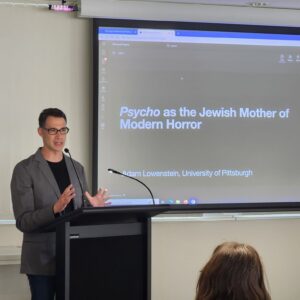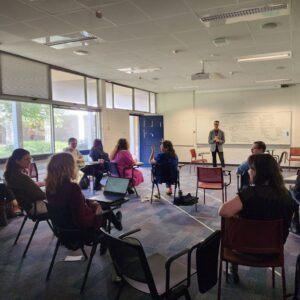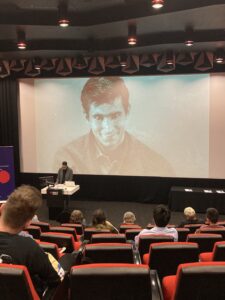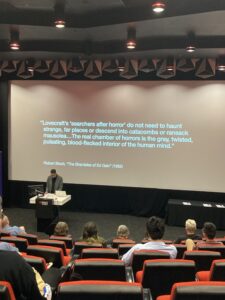Compiled and edited by Claire Henry
In March 2023, esteemed horror scholar Professor Adam Lowenstein (University of Pittsburgh) visited Australia and was hosted by SSAAANZ Executive Committee members Dr Jessica Balanzategui (RMIT University) in Melbourne, Dr Claire Henry (Flinders University) in Adelaide, and Dr Max Bledstein (UNSW) in Sydney. SSAAANZ offered travel bursaries to support higher degree and early career researcher (HDR/ECR) members to participate in the associated events. The lucky bursary recipients – Corey Cribb, Ben Levin, and Rebecca Weeks – report back from their time in Adelaide and Melbourne below. SSAAANZ also supported the Sydney book launch of Horror Film and Otherness (Columbia University Press, 2022), which kicked off Prof. Lowenstein’s trip and was a valuable networking event for the Sydney screen studies community. Following the route of Prof. Lowenstein’s national tour, we present a chronicle of the events held in Sydney, Adelaide, and Melbourne.

Sydney
by Max Bledstein (UNSW)
Prof. Lowenstein’s visit to Sydney included the Australian launch of his latest book, Horror Film and Otherness. The event was co-hosted by SSAAANZ and the Sydney Screen Studies Network (SSSN) and held at UNSW. Prof. Lowenstein began by reading from the introduction of the book, in which he powerfully argues for the importance of what he calls “transformative otherness,” which describes how horror films use the fluidity between normality and monstrosity to tackle issues of difference and identity. He foregrounded the discussion of transformative otherness through moving anecdotes about his life as a Jew in Pittsburgh, which led him to reflect on the tragic mass murder at the Tree of Life synagogue and the loss of Pittsburgher George A. Romero. These reflections were followed by a spirited Q&A session, in which Prof. Lowenstein engaged in thoughtful discourse about the book and horror more broadly with the audience of staff and students. The evening was an excellent occasion to hear about Prof. Lowenstein’s new book and exchange ideas about horror.
Adelaide
by Corey Cribb (University of Melbourne)
In keeping with the festive character of Adelaide in March, an invigorating schedule of events was arranged to coincide with Prof. Lowenstein’s tenure as Distinguished Visiting Research Fellow in Screen at Flinders University.
On 9th March, staff and students congregated at Flinders to hear Prof. Lowenstein’s compelling paper “Psycho as the Jewish Mother of Modern Horror”, during which Lowenstein not only cast new light on a horror classic by attending to the film’s “Jewish sensibility” but also gave those in attendance some insight into his current research project on Jewish horror cinema. Prof. Lowenstein’s talk was followed by a presentation from Dr Claire Henry, who introduced her own exciting new project on contemporary female directed surrealist horror cinema. Together the seminar provided a sample of what was to come at the Mapping Global Horror conference (see below).
After the seminar, Prof. Lowenstein enjoyed a tour of the 16mm film collection (State Film and Video Library of South Australia Collection) at URSSA, offering ideas to Flinders’ screen staff and librarians from his involvement in obtaining the Romero archives and establishing the Horror Studies Collection at Pitt.

That evening, the Adelaide screen studies community assembled at the beloved independent cinema, Mercury, for a screening of the Australian horror film Cargo (2017) introduced by Prof. Lowenstein and succeeded by a Q&A with co-directors Yolanda Ramke and Ben Howling. The audience was treated to a rich discussion that spoke to the interests of local filmgoers, film students and emerging filmmakers alike.
On 10th March, Prof. Lowenstein led a workshop for the HDRs and ECRs in Screen and Media Studies at Flinders. He began by contextualising Screen Studies as a discipline once united by a set of shared concepts, theories, and texts, addressing the changes that have taken place across the past four decades to its centre and periphery. Drawing on his own experience in bringing together the particular (horror cinema) and the general (screen studies) when writing Horror Film and Otherness (2022), Prof. Lowenstein provided attendees with a welcome platform to voice their own research-related dilemmas and anxieties.
In the afternoon, Prof. Lowenstein spent some time with 3rd year Flinders’ students who were studying screenlife and spectatorship in the Contemporary Screen Cultures topic with Dr Claire Henry. The busy two days concluded with networking drinks at ‘The Tav’ on Flinders’ Bedford Park campus, which was a further opportunity to get to know the Screen staff and postgraduates at Flinders who were welcoming hosts for my trip to Adelaide.
Melbourne
by Ben Levin (UNSW)
Prof. Lowenstein kicked off the first talk of #MarchHorrorMayhem with a forceful assertion that Psycho is the Jewish mother of modern horror — a subject of his forthcoming book about Jewish horror. Reconsidering Robert Bloch’s original novel as central to understanding the wider Psycho phenomenon, Prof. Lowenstein traces the author’s Jewishness through constant allusions to the Holocaust through his work and a Borsht Belt background that influenced his macabre tales. Coinciding with the emergence of the overbearing Jewish mother stereotype found in Catskills routines of the 1950s, the novel takes the joke to its logical extremity and into the realm of horror, where the trope is inverted to tell us to stop blaming the Jewish mother for the crimes of the Jewish son. Hitchcock’s adaptation, Prof. Lowenstein contends, enriched Bloch’s initial themes, rather than removing them from the film. Prof. Lowenstein opened the floor to questions, leading to discussions that ranged from how Hitchcock’s experience of being an immigrant and witnessing Holocaust footage early in his career rippled into his filmography and how the shifting allegiances in the film’s parlour scene can be viewed as a re-enactment of the perpetrator-victim relationship that is vital to Holocaust and trauma studies.


During the second part of the day, Prof. Lowenstein led a workshop for HDRs and ECRs on foundations and specialisations in film and media studies. Acknowledging the movement from the Society for Cinema Studies’s foundation first and specialisation second model to the specialisation first and foundation second approach of Society of Cinema and Media Studies (SCMS), Prof. Lowenstein stressed the importance of bridging academic focus with larger disciplinary issues and non-academic research interests. Participants then proceeded to share their current research and were encouraged to find commonalities that could fulfil this goal. Prof. Lowenstein also offered further sagely advice to early career researchers such as attending the SCMS conference and gaining practical film experience to enable teaching both theory and production.
Mapping Global Horror: Australia, Japan & Beyond
by Rebecca Weeks (Media Design School, Auckland)
Mapping Global Horror: Australia, Japan & Beyond kicked off with a panel on women in horror. Drawing upon her recent book, 1000 Women in Horror, 1895-2018, Alexandra Heller-Nicholas argued that women “have been hidden in plain sight” in the genre. She pointed out that archives have not been kind to female horror filmmakers and commended colleagues who collect and release horror films created by women, making them available for wider consumption and preserving movies that might otherwise be lost. Charles Exley’s presentation focused on the work of Japanese filmmaker Kayoko Asakura, a special guest of the conference. Exley outlined how Asakura’s films, including My Girlfriend is a Serial Killer (2019) which screened on Saturday night, reorient the tropes of the genre that viewers are familiar with. Chika Kinoshita discussed Japanese horrors through the lens of motherhood with a particular focus on the fetus and the rise of gynaehorror. The final presenter, Claire Henry, shifted the conversation towards surrealist aesthetics in the works of female directors Lucile Hadžihalilović, Agnieszka Smoczyńska and Jennifer Lynch.
The Romero panel surveyed the legacy of the cult-horror filmmaker. First, Angela Ndalianis looked at the far-reaching impact of the Romero ‘Living Dead’ films, exploring tropes and conventions that emerged in force during the Covid-19 pandemic. Drawing upon criticisms of Romero’s body of work, Professor Lowenstein argued that we should not separate the social from the psychological, or value one type of horror film above the other. Lowenstein drew upon two films about aging itself to examine his thesis: Natalie Erika James’ Relic (2020) and Romero’s Amusement Park (1973). Reese Goodwin, the film and TV director of ACMI, also spoke about the specially curated film programme ‘Focus on the Dead’ that accompanied the conference and runs throughout the month of March. This programme includes not only 4K and 3D screenings of Romero’s work but also a thoughtfully curated selection of zombie-related films.

After hearing so much about the George A. Romero Archival Collection at the University of Pittsburgh, it was fascinating to see Ben Rubin’s prerecorded virtual tour. The annotated scripts, treatments and production materials for both produced and un-produced projects will allow scholars to explore the full scope of Romero’s creative genius. The panel concluded with a special screening of Romero’s Elegy (1963) which is currently being restored. As Lowenstein noted, this 20-minute-long segment for a film that was never released, will undoubtedly change how scholars interpret Night of the Living Dead (1968) and the film’s African American hero. The plea to consider contributing to the restoration funds shows that even a filmmaker as esteemed as Romero needs the help of the community to preserve his work.
The final panel of the day, which focused on folk horror, was grounded by Jessica Balanzategui and Allison Craven’s exploration of the “folk horror feeling,” which introduced the “Unholy trinity” of folk horror films: The Wicker Man (1973), The Blood on Satan’s Claw (1971) and Witchfinder General (1968). Balanzategui and Craven suggest that folk horror is a feeling rather than a set of fixed identifiers, a subgenre that is “felt” rather than “defined”. Indeed, their thesis was qualified by the following panelists who approached folk horror from a variety of angles. Some, like Saige Walton’s study of Alex Garland’s Men (2022), examined more familiar tropes of folk horror, including the natural, rural and animal through the lens of philosopher Gaston Bachelard. Akira Lippit and Bliss Cua Lim offered an alternative vision of folk horror, looking at global folk-horror films. Lipitt considered the trope of extreme loneliness and emptiness that pervades Japanese horror, while Lim discussed the borders between on- and off-screen space in meta media narratives, such as Don’t Look Up (1996).
The first day concluded with a screening of James’ Relic, a rare opportunity to see this intergenerational horror on the big screen. Although James’ film might not have made it into cinemas in many countries (moving straight to streaming due to COVID-19), the impact of her work has not been any the less for it. Relic was the subject of Lowenstein’s presentation at this conference, as well as a number of presentations at the SSAAANZ 2022 conference. James’ Q&A with Heller-Nicholas after the screening gave viewers the chance to ask her about design choices in the film, as well as questions about making a feature film with US funding.
On day two, the conference switched to a roundtable format, allowing for a more informal and free-wheeling conversation between participants and the audience, as well as among participants themselves. The first roundtable of the day tackled the issue of streaming services and the place of horror (and genre more generally) on first, second and third-tier platforms. The conversation between Alexa Scarlata, Andrew Lynch, Jessica Balanzategui and Mark David Ryan explored how horror is produced, acquired and marketed on SVODs. A key concern was competing forces at play between niche streaming services like Shudder and more mainstream generalist streaming services. The breadth of the participant’s knowledge on all aspects of streaming—from business models to viewership—was evident as they traversed the constantly fluctuating streaming landscape.
The second roundtable saw Adam Daniel in conversation with Kayoko Asakua, Natalie Erika James, Isabel Peppard and Caitlin Koller. Refreshingly, the roundtable was billed as “Filmmakers on Horror”, not “Female Filmmakers on Horror.” The fact that all four filmmakers were women was incidental, and simply demonstrates the strength of female horror filmmakers in the Asia-Pacific region. The filmmakers, all with vastly differing experiences and approaches to filmmaking, shared the challenges and triumphs of working in the horror genre as well as what messages they hope to put out into the world with their body of work.
After lunch, film exhibition and festival convenors including Grant Hardie, Hudson Sowada, Lee Gambin and Briony Kidd engaged in a roundtable with Balanzategui and Ndalianis. Their shared love of cinema was palpable, as was their desire to bring film—whether horror, experimental or classic—to audiences. Each discussed their approach to programming, including commercial considerations, marketing and debates over genre. As well as celebrating the power of festivals to build film communities, they touched upon difficulties, with Kidd remarking that there is very little understanding of how crucial festivals are to the filmmaking ecosystem. A common thread was the challenge to secure funding, partnerships and support to keep these festivals and organisations going.
In the final roundtable, Lippit, Kinoshita, and Lim were joined by Stacey Abbott and Kris Woofter to address the conference’s title theme, “Mapping Global Horror,” which was chaired by Prof. Lowenstein and Ndalianis. Presenters were given free rein to connect the dots between the panels and draw out the key themes that spoke to them across the conference. The presenters were still clearly grappling with issues of genre, transmutability, and empathy, to name just a few. Undoubtedly, these topics will continue to be explored at the next conference.
The conference ran incredibly smoothly, thanks in part to the expertise of the ACMI staff who made sure the tech was working properly and thanks, of course, to the organisers: Jessica Balanzategui, Andy Lynch, Angela Ndalianis, Adam Lowenstein and Charles Exley, who designed a rich and varied programme. Having a mix of panels and roundtables and a single stream of presentations created an atmosphere that was both invigorating and intimate. Rom-coms popped up during several panel discussions, and while it was a horror conference, it played out much more like a rom-com, with lots of love, respect, and laughter in the room.

Add a comment